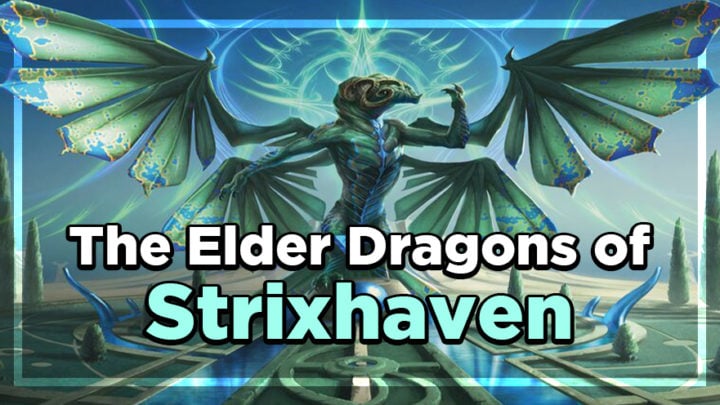After covering the complex utility of the Strixhaven Commands at the start of spoiler season and then the ultra-wordy, double-faced Deans cycle in my last column, I wanted to follow up with something a little more classic and straightforward. Luckily enough, there’s a third cycle of college-defining cards which fit the bill for us battlecruiser Magic enthusiasts: the Elder Dragons who founded them!
RESPECT YOUR ELDERS
The first cycle of Elder Dragons were a part of Legends back in 1994 — the set which brought legendary (and multicolor) cards into the game. There were more than a few legendary creatures to choose from, of course, but the Elders stood out. From their colorful art and giant statlines to their equally over-the-top mana cost and upkeep, they were the most exciting creatures in Magic.
The mightiest among them, Nicol Bolas, was so iconic he stuck around for a lengthy career as Magic’s recurring villain, one that ended only recently. But all five were deemed worthy of a more modern depiction alongside Nicol Bolas, the Ravager as mythic rares in M19. Apart from those OGs, the only other time the Elder honorific was busted out was for the Dragonlords of Tarkir — but only in the revised timeline where their domination of that plane was complete. The original Dominarian Elder Dragons have also been tied deeply to the history and fate of that plane. So the fact that these new Strixhaven Dragons are card-carrying Elders actually tells us a lot about the history and lore of Arcavios.
But the most important thing about this prestigious class of creatures is that they inspired a group of early Magic players to try dueling with decks led by a specific Elder. The casual fun of “Elder Dragon Highlander” soon expanded to include other legendary creatures and many other playgroups, until it was eventually adopted by WotC as Commander – now the most popular way to play Magic worldwide!
So, at the very least, we can assume these new Elder Dragons will make for exciting Commander choices; it’s part of their heritage, after all. But will they also hold up as Standard curve-toppers? Let’s take a look and find out!
GALAZETH PRISMARI
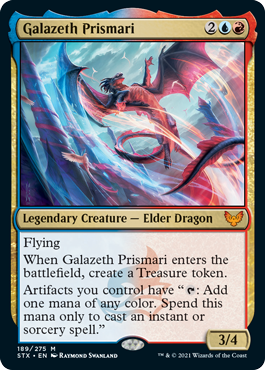
If you are just here to hear about the hottest new Standard bombs, let me get the most obvious pick out of the way first. Galazeth is the cheapest of the new (well, new as Elders can be) brood, and gets even cheaper once you factor in the free Treasure — a Treasure that is actually a reusable mana rock so long as Galazeth sticks around!
Sure, that’s a pretty light board impact for a mythic rare legend, and I imagine Commander players without dedicated Treasure decks or a love-shrine to Dockside Extortionist are a little disappointed. But it does play nicely with the themes of the college, leaving the top of the curve open for Prismari’s gigantic sorceries and helping to hold back enemy combat until your Treasure-ramp can cast them.
Speaking of Treasures, any deck considering Galazeth is going to be looking for a few other sources of them to get some extra juice out of their Dragon. Prismari Command looks like a safe place to start, but I’m particularly appreciative of the built-in synergy with the aforementioned sorcery payoffs. Creative Outburst, Elemental Masterpiece and Magma Opus are where every Prismari deck will be hoping to get to, and by “Treasure-cycling” one of them on turn two, you’ll be able to immediately ramp into a turn three Galazeth! When the dust settles, you’ll still be ahead with five mana on turn four, with a sizable flyer and permanent Treasure tokens to start busting out your most dazzling spells.
BELEDROS WITHERBLOOM
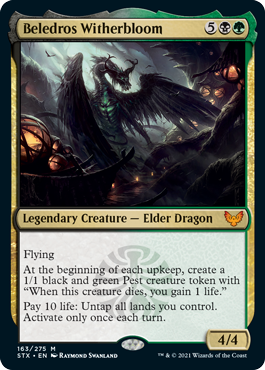
At the other end of the scale-y scales is this GB heavyweight, topping out at a mighty seven mana value. While the 4/4 body might not reach your expectations for that hefty cost, Beledros’s unique activated ability certainly does — converting life directly into mana by way of untapping all your lands! The ludicrous excess of a seven-mana ramp spell practically screams “Commander,” and given how easily you can go infinite by using that mana to flicker, reanimate or recast Beledros, I expect this to quickly join the staples of that format.
Constructed players tend to need a bit more convincing around a card this costly, and the fact that Beledros is really more enabler than payoff is another “F” on its Standard report card. But with the amount of flickering, reanimation and freecasting in the upcoming format, I don’t think this jumbo untapper can be so easily dismissed.
I’m especially interested in the combo with an even more expensive Strixhaven bomb: Jadzi, Oracle of Arcavios. Both pieces being creatures means you can use the same tools to reanimate or otherwise cheat them into play; either one can help immediately cast the other, and Beledros’s giant mana reload can give Jadzi the juice to get most of your deck into play the same turn. You’ll definitely catch me testing this deck out when the Strixhaven Arena preview event rolls around.
SHADRIX SILVERQUILL
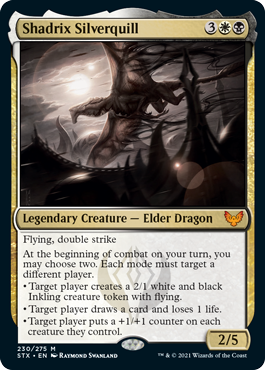
Perhaps I’m just more critical when it comes to my darling WB color combo, but just like Silverquill’s Deans, this Elder Dragon leaves me with mixed feelings. At first blush, Shadrix appears quite similar to Rankle, Master of Pranks — a proven success in Standard aggro and midrange lists. But Rankle’s modal effects acknowledge that these decks are usually playing an attrition game; two out of three leave the opponent down a card. Rankle also starts triggering those abilities a turn earlier than Shadrix, and starts attacking two turns earlier. The Elder Dragon’s options are confusing by comparison, not to mention a little small-ball for a card you’re likely deploying on turn six or seven in most games.
But more than raw power, what Shadrix really lacks is a way to feel like you’re “breaking it” with the options on its ability. Rankle’s triggers only look symmetrical; the most fun part of the card is when you sac Woe Strider’s goat in return for their Questing Beast, or trigger the mutual discard with no cards in hand. The only comparable situation for Shadrix is giving the counters option to a creatureless control or combo deck, but that’s also where the extra damage from those counters is most appealing. And I’m loath to give my opponent a blocker or an extra chance to draw removal when I’m about to attack with Shadrix! The trigger might be optional, but that is really not the kind of choice I’m excited about making.
I don’t want to write off Shadrix Silverquill too soon, but it does feel like the high point of the card is duplicating Basri’s Solidarity the turn it comes down. Perhaps giving opponents Inklings will combo well with Kaervek, the Spiteful? I’m left with a creeping hunch that somewhere in its design history, Shadrix gave you two abilities per turn to your opponent’s one, which would be not only more viable but open up far more interesting lines. Alas, we’ll never know. At least Commander players get a general for WB counters.
TANAZIR QUANDRIX
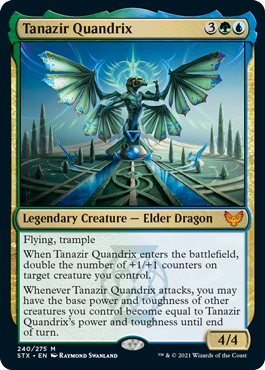
Fittingly for the Quandrix, evaluating their founder Dragon turns out to be a real puzzle! Tanazir definitely has the raw potential to make the cut in a Standard UG Counters list. The question is, will such a deck actually exist? Similar payoffs like Roalesk, Apex Hybrid have been left untouched in recent years, and the current counters synergies seem to lean much harder towards Abzan.
Even Tanazir’s second ability is hard to synergize with the first, since you’d rather copy the power of whatever other thing just had its counters doubled. The unifying factor seems to be the Quandrix’s affinity for 0/0 Fractal tokens, so the strength of those cards will largely determine the playability of this legend in Standard. But older formats do open up some more ways to build around counters. Hadana’s Climb is easily flipped the turn you play it in Historic, and not only sets up an early Tanazir, but re-doubles the impact of both its abilities!
Furthermore, Tanazir seems like an incredible ready-made Commander pick, bringing scaling value and sky-high potential to any aggressive UG list. The combination of flying and trample with an ability emphasizing pump effects threatens both Commander and conventional lethal in combat, and the presence of the word “double” alone is exciting to a whole swathe of players. It’s a fun and powerful design – the first time in a while I’m excited to see the new UG mythic legend hit the table.
VELOMACHUS LOREHOLD
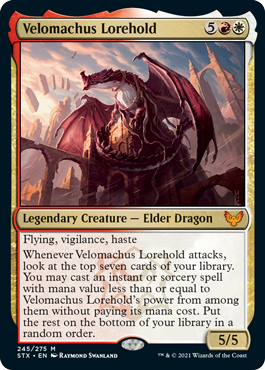
Apologies to my fellow Lorehold-appreciators who’ve been kept waiting, but I just had to keep the best for last! Sure, this Elder is tied for the highest cost with Beledros, but you get massive immediate and ongoing value. The attack trigger offers massive flexibility and should at least make it impossible to block Velomachus through all the free removal and combat tricks. I’m a little confused that it won’t hit artifacts or enchantments, but I admit a Sunforger homage is the perfect response to all the Commander players who’ve been pining for a less creature-focused Boros commander.
Of course, a fine play for seven mana tends to be back-breaking for four or five — and luckily, that’s how much I expect to regularly be playing this for! Whether you’re pairing Transmogrify or Lukka, Coppercoat Outcast with Lorehold Command or combining Magda, Brazen Outlaw with Augusta, Dean of Order, RW is rife with ways to power out an early Elder Dragon. And while you could technically use them to summon any of this new cycle, Velomachus is both on-color and the best individual payoff.
You can turbo it out even harder if you can manage some inter-college collaboration with Prismari and their Treasure synergies. And with only a little pre-combat pumping, the attack trigger can be coaxed into freecasting those signature high-cost sorceries, too. Velomachus and Galazeth definitely win my yearbook award for “most eligible team-up” among this cycle.
FOUNDERS, NOT FOUNDERING
I was a little worried about how these Dragons would find space mechanically alongside the Deans, but they turn out to be a great contrast to that cycle. They’re all individually impactful rather than pure build-arounds, and focus on combat more than utility. Each one looks to have solid potential in Elder Dragon Highlander, as is only right. That being said, I’m almost surprised at how restrained these abilities are compared to previous Elder Dragon cycles, especially since recent creatures have trended towards higher complexity and power. I suspect the Deans have a lot to do with that as well — two faces of interwoven triggered and activated abilities must have taken a massive chunk out of the set’s overall word budget.
At least these Elders all impact the board on the turn they enter, which puts them in the equation for Constructed playability. But even if they won’t be foundational to any new Standard format, I think the metagame will be healthier for their existence. It’s nice to have some deckbuilding puzzles for the curious or dragon-obsessed among us. And if my instincts are right, we’ll see at least one or two of those puzzles solved by the time Strixhaven season runs its course!

Tom’s fate was sealed in 7th grade when his friend lent him a pile of commons to play Magic. He quickly picked up Boros and Orzhov decks in Ravnica block and has remained a staunch white magician ever since. A fan of all Constructed formats, he enjoys studying the history of the tournament meta. He specializes in midrange decks, especially Death & Taxes and Martyr Proc. One day, he swears he will win an MCQ with Evershrike. Ask him how at @AWanderingBard, or watch him stream Magic at twitch.tv/TheWanderingBard.

